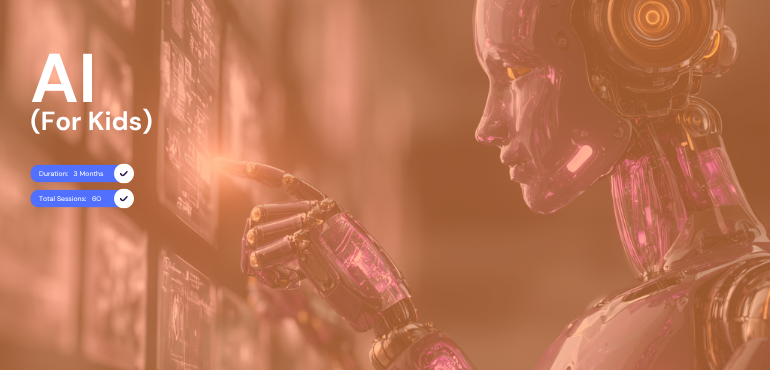Course Overview
This exciting program introduces kids to the world of Artificial Intelligence in a fun, creative, and hands-on way. Over 25 sessions, learners explore how AI works, how it learns from data, and how it powers games, chatbots, art, and even music. Each session blends short explanations with coding practice, group activities, and mini projects like building chatbots, creating funny sentences, cartoonizing images, or making AI-powered games. The course ends with a Final Showcase, where kids present their own AI projects at an AI Fair for friends and family.
Course Content
- Topic
• What is AI?
• AI vs Human Brain
• Python Refresh
• Data & AI
• Intro to Machine Learning
• Images & AI
• AI & Games
• Classification Basics
• Decision Trees
• Data Visualization
• Intro to NLP (Text AI)
• Bag of Words
• Sentiment Analysis
• Chatbots
• Intro to Neural Networks
• AI in Vision
• Image Filters
• Training a Simple Model
• AI for Games (Part 2)
• Generative AI
• AI & Ethics
• AI in Music
• AI Art
• AI Projects
• Final showcase
- Key Concepts
• Real-world AI examples (games, chatbots, self-driving cars)
• How machines "learn"
• Variables, loops, functions (quick recap)
• What is data? Why AI needs data
• Training vs Testing
• Pixels explained
• How AI plays games
• Labels & categories
• How AIs “choose”
• Graphs & plots
• How AI understands words
• Representing text with numbers
• Positive vs Negative text
• Rule-based chatbots
• Neurons, layers (kid-friendly version)
• How AI “sees”
• Transforming images
• Using scikit-learn (linear regression)
• Reinforcement learning basics
• AI that creates (text, images)
• Bias, fairness, deepfakes
• How AI makes music
• Intro to AI image generation
• Group project planning
• Present projects
- Mini Project / Activity
• Spot AI in daily life (group activity)
• Draw a “Robot Brain” diagram
• Build a calculator
• Collect favorite movies/colors in a list
• Guessing favorite fruit with simple rules
• Load and display an image in Python
• Build a dice-rolling simulator
• Classify animals into “Pets” or “Wild”
• Make a decision tree quiz (yes/no questions)
• Plot favorite sports using matplotlib
• Count words in a story
• Word frequency counter
• Check if a sentence is “happy” or “sad”
• Build a simple chatbot (if/else logic)
• Draw a neural net diagram
• Detect simple shapes in an image
• Create a “cartoonizer” with PIL
• Predict ice cream sales vs temperature
• Rock, Paper, Scissors with computer player
• Generate random funny sentences
• Debate: “Should AI grade exams?”
• Generate simple tones with Python
• Create abstract art with random patterns
• Choose between chatbot, art, or game
• AI Fair: demo to friends/family
- Teaching Notes
• Balance: Each session = 10–15 min explanation → 30 min hands-on → 10–15 min wrap-up.
• Tools: Use Python + beginner-friendly AI libs (scikit-learn, transformers, PIL, matplotlib). If not coding-heavy, use web-based AI tools (Teachable Machine, Scratch with AI, RunwayML).
• Fun First: Kids engage better with games, chatbots, art, and stories than raw math.
Absolutely! Many AI courses are designed specifically for beginners. They start with foundational concepts and often use beginner-friendly tools and platforms that minimize complex coding. Look for courses labeled "Introductory," "No-code AI," or "AI for Everyone." These will help you build a solid understanding of the principles before you advance to more technical, programming-heavy topics.
These terms are often used interchangeably, but they represent a hierarchy of concepts:
- Artificial Intelligence (AI) is the broadest field, focused on creating machines capable of intelligent behavior.
- Machine Learning (ML) is a subset of AI that gives computers the ability to learn from data without being explicitly programmed for every task.
- Deep Learning (DL) is a further subset of ML that uses complex neural networks to solve advanced problems like image and speech recognition.
Most foundational courses will cover the relationship between these fields, while specialized courses will dive deep into one area.
Our courses are project-based to ensure you gain hands-on experience. You'll work on real-world projects such as building a movie recommendation system, developing a chatbot, or creating an image classifier. These projects form a practical portfolio that demonstrates your skills to employers. This hands-on approach prepares you for roles like AI Specialist, Machine Learning Engineer, or Data Analyst, and equips you with in-demand skills to solve business problems.





